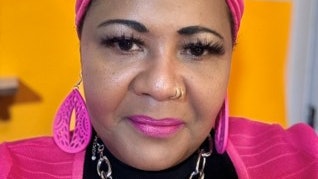Imagine this. I am a rather strong person, someone who is willing to take on challenges that inhibit Black and other minoritized children from reaching their potential in schools and society. When raising my son (now an adult and father), I always found parent-teacher conferences intimidating. Imagine that. There was usually more than one teacher, so I felt outnumbered. But as an educator myself, I knew that attending the meetings was essential so that educators would not dare to mistreat my son. Even after getting my doctoral degree and could attend the meetings as ‘Dr. Ford’, I was never called such. When my (former) husband, a university dean, would accompany me to meetings, I still felt outnumbered and on the defense. Imagine that. If this can happen to me with my credentials, what are other Black caregivers feeling about home-school relationships?
 Dr. Donna Y. Ford
Dr. Donna Y. Ford
“Family engagement is a full, equal, and equitable partnership among families, educators, and community partners to promote children’s learning from birth through college and career.”
A litany of data and reports overwhelmingly demonstrate that families matter in every way, having a significant impact on all aspects of their children’s overall well-being – academically, cognitively, socio-emotionally, psychologically, and vocationally. Given the lower achievement and other negative outcomes of Black and Hispanic students in our schools often due to racial prejudice and discrimination (i.e., achievement and opportunity gaps, underachievement, excessive and unjust suspensions and expulsions, overrepresentation in special education, and underrepresentation in gifted and talented education, Advanced Placement), it behooves educators to not just increase minoritized students’ engagement, but to also increase their family’s engagement.
In 2022, the U.S. Department of Education created the “National Parents and Families Engagement Council to Help Ensure recovery Efforts Meet Students’ Needs.” More specifically, the council is designed to facilitate strong and effective relationships between schools and parents, families and caregivers. Families’ voices play a critical role in how the nation’s children are recovering from the pandemic (and more). They recognize the timeless adage that “Parents are a child’s first teachers, and there’s no one better equipped to work with schools and educators to identify what students need to recover” (U.S. Secretary of Education Dr. Miguel A. Cardona).
The council consists of parent, family, or caregiver representatives from national organizations that will work with the department to identify constructive ways to help families engage at the local level…. The council is a channel for parents and families to constructively participate in their children’s education by helping them understand the rights they have, create a feedback loop with schools to shape how American Rescue Plan (ARP) funds are deployed to meet students’ needs, and identify summer learning and enrichment opportunities for children in their communities.
Barriers to Black family engagement are numerous, too many to share in this short piece where I focus on school-based roadblocks. Mapp and Bergman (2021) in The Carnegie Reporter, and Good Reason Houston share several:
1. Black families are excluded from, or avoid, discussions about their children’s education.
Families may avoid conversations with their children’s schools due to past anxieties as students themselves, previous negative advocacy attempts, or fear of retaliation targeting us or our children. When teachers and principals lack culturally responsive relationships with families, they often rely on deficit thinking — stereotypes and prejudice — to justify not reaching out to Black and minoritized families to build partnerships. Whether intentional or unintentional, the lack of or inadequate collaborations have negative consequences for Black and other marginalized students.
2. Black families frequently arrive at school to be treated like students themselves.
We spend an hour with parent/family liaisons and community outreach coordinators who instruct us on the importance of reading at home to overcome vocabulary gaps or how to navigate systems at school. While important, there is often no space for the caregiver to be heard. Despite this, we know that “Parents provide critical perspective, and they should always have a seat at the table whenever decisions are made that impact their children” — Anna King, president of National Parent Teacher Association (PTA).
3. Minoritized families are treated at best as spectators of the work of schools. They are seen but not heard; expected to show up but not speak up. When absent from meetings, the deficit-grounded misinterpretation is that Black families do not care about their children, school, and learning. How they are viewed is communicated loudly and clearly, and contributes to families feeling disempowered and discouraged about physically coming to school events and meetings. The atmosphere is too unwelcoming, as noted about with my experiences.
4. The cultural capital of minoritized families is overlooked or devalued. Families are frequently excluded from decisions about their children, including how to educate them. Their culturally-grounded ways of raising their children are discounted and not infused into pedagogical practices and strategies (e.g., instruction, teaching styles, learning styles). Topics and people that they want their children to learn about are not taught in the curriculum (e.g., content, books events, topics, issues). I have written extensively about cultureblind curriculum and its myriad of problems. This propelled me to write a tribute to the father of multicultural curriculum and to create my Bloom-Banks Matrix.
5. Family engagement efforts often take on an assimilation function. Traditional structures and dynamics often shape school efforts. Stated another way, educators take on the role of the authority of what minoritized students and their families need, resulting in a power imbalance between homes and schools. Again, the wants and needs of Black families are discounted, rendered inconsequential to their children’s educational experiences and needs.
The aforementioned challenges and barriers result in Black and other minoritized families feeling helpless, invisible, unwelcomed, discounted, and disenfranchised.
Moving forward: engaging Black and other minoritized families in schools
The Connecticut Department of Education and its framework lay out full, equal, and equitable partnerships in (a) early childhood, (b) elementary schools, (c) middle and high schools, and (d) after-school programs, with an additional chapter on reducing chronic absenteeism. There’s a wealth of information in each chapter.
Henderson offered several solid recommendations, along with Mapp and Bergman in “toward a more liberatory approach to family engagement.”
- Begin with asking Black caregivers what their dreams are and aspirations for schools.
- Design action plans in schools that align with the dreams and aspirations of Black families. When we design change for the most marginalized in our community, we will have more positive impact on the broader community.
- Hold school-related meetings in churches or community spaces that are in proximity to the neighborhoods of Black families and affirm their cultural identities and realities.
- Always believe that Black families are cultural experts and possess knowledge of stories and practices used to advocate for their children in schools.
- Create spaces that allow Black families to feel safe and secure and support them with childcare, food, and resources for well-being and wellness.
- Build relationships based on mutual trust.
- Adopt an asset-based philosophy and approach when working with culturally different families. Minoritized families possess a wealth of knowledge that should be drawn on to support students learning and development. Educators can use these funds of knowledge to enhance curricular and pedagogical strategies.
- Be culturally respectful and responsive. This requires becoming culturally competent in dispositions, knowledge, and skills.
- Avoid hierarchical relationships; instead, relationships must be equitable and reciprocal. The role of minoritized family is as valuable and invaluable as that of educators.
I want to end with this assertion by the Carnegie Corporation: “The relational condition must be prioritized for equitable partnerships between home and school to be cultivated and sustained.”
To play on an adage mainly associated with students: Families (too) don’t care what you know, until they know that you care.
Dr. Donna Y. Ford is a Distinguished Professor of Education and Human Ecology at The Ohio State University.
#School #Means #Increasing #BlackMinoritized #Family #Engagement










